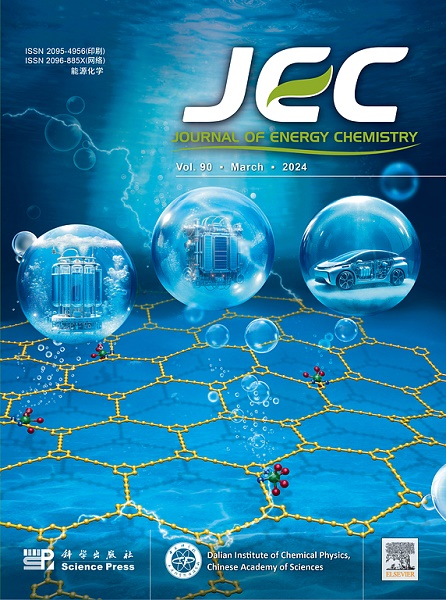A multifunctional separator decorated by anionic metal–organic framework toward ultrastable zinc anodes
IF 13.1
1区 化学
Q1 Energy
引用次数: 0
Abstract
Aqueous zinc ion batteries (AZIBs) have excellent development prospects due to their high theoretical capacity and low cost. Nevertheless, the commercial separator represented by glass fiber (GF) in AZIBs usually exhibits uneven porosity, poor zincophilicity, and insufficient functional groups, resulting in the emergence of the zinc anode dendrites and side reactions. Designing a separator with specific interfacial ion transport behavior is essential to achieve a highly stable reversible zinc anode. Herein, an anionic metal–organic framework (MOF) functionalized separator (GF-Bio-MOF-100) was presented to accelerate the desolvation process and modulate Zn2+ flux, thereby delivering the decreased nucleation overpotential and uniform Zn2+ deposition. The in-depth kinetics investigations combined with the in-situ Raman spectroscopy demonstrate that the carbonyl group within the Bio-MOF-100 is capable of capturing the H2O molecules of [Zn(H2O)6]2+ via the H-bond interaction, which further accelerates the desolvation process and transport kinetics of Zn2+. Meanwhile, the anionic framework of the GF-Bio-MOF-100 separator acts as an interfacial ion channel to regulate the Zn2+ flux and enables dendrite-free Zn2+ deposition and growth. Consequently, the Zn|GF-Bio-MOF-100|Zn symmetric cell exhibited a stable Zn2+ plating/stripping behavior and it could cycle for 2000 h at 0.3 mA cm−2. Additionally, the assembled Zn|GF-Bio-MOF-100|MnO2 full cell delivers a capacity retention of 83.9% after 1000 cycles at 0.5 A g−1. This work provides new insights into the design of functionalized separators for long-life AZIBs.

求助全文
约1分钟内获得全文
求助全文
来源期刊

Journal of Energy Chemistry
CHEMISTRY, APPLIED-CHEMISTRY, PHYSICAL
CiteScore
19.10
自引率
8.40%
发文量
3631
审稿时长
15 days
期刊介绍:
The Journal of Energy Chemistry, the official publication of Science Press and the Dalian Institute of Chemical Physics, Chinese Academy of Sciences, serves as a platform for reporting creative research and innovative applications in energy chemistry. It mainly reports on creative researches and innovative applications of chemical conversions of fossil energy, carbon dioxide, electrochemical energy and hydrogen energy, as well as the conversions of biomass and solar energy related with chemical issues to promote academic exchanges in the field of energy chemistry and to accelerate the exploration, research and development of energy science and technologies.
This journal focuses on original research papers covering various topics within energy chemistry worldwide, including:
Optimized utilization of fossil energy
Hydrogen energy
Conversion and storage of electrochemical energy
Capture, storage, and chemical conversion of carbon dioxide
Materials and nanotechnologies for energy conversion and storage
Chemistry in biomass conversion
Chemistry in the utilization of solar energy
 求助内容:
求助内容: 应助结果提醒方式:
应助结果提醒方式:


